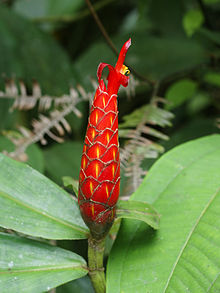| Costus | |
|---|---|

| |
| Costus pulverulentus in Costa Rica | |
| Scientific classification | |
| Kingdom: | Plantae |
| Clade: | Tracheophytes |
| Clade: | Angiosperms |
| Clade: | Monocots |
| Clade: | Commelinids |
| Order: | Zingiberales |
| Family: | Costaceae |
| Genus: | Costus L.[1] |
| Synonyms[1] | |
Costus is a genus of herbaceous perennial plants in the family Costaceae, erected by Linnaeus in 1753.[2][3] It is widespread through tropical and subtropical regions of Asia, Africa, and the Americas.[1][4][5]
Costus is often characterized and distinguished from relatives such as Zingiber (true ginger) by its spiraling stems. The genus as a whole is thus often called spiral gingers, but this can also refer to C. barbatus specifically.[citation needed] It is important not to confuse Costus scaber, C. spectabilis etc. with the herb known by the common name "costus".
Costus spectabilis is the floral emblem of Nigeria; its flowers are represented (erroneously in red instead of yellow color) on its coat of arms.[6]
Costus productus and Costus guanaiensis are among the species of Costus with edible flowers.[7][8][9] Other Costus species' flowers have also been determined to be edible.[10][11]
Some Costus species have traditional medicinal and veterinary uses. For example, in Trinidad and Tobago, a mix of Costus scaber juice and crushed Renealmia alpinia berries is used to treat dogs bitten by snakes.[12]
Costus naturally hybridizes, and commercial hybrids have also been produced.[13]
- ^ a b c Cite error: The named reference
POWOwas invoked but never defined (see the help page). - ^ Cite error: The named reference
LINNAEUSwas invoked but never defined (see the help page). - ^ Cite error: The named reference
TROPICOSwas invoked but never defined (see the help page). - ^ Cite error: The named reference
FOCwas invoked but never defined (see the help page). - ^ Cite error: The named reference
SPECHTwas invoked but never defined (see the help page). - ^ "The National Flower of Nigeria: Costus Spectabilis". Nigerian Embassy in Tel-Aviv, Israel. 28 April 2019. Archived from the original on 19 July 2024. Retrieved 3 August 2024.
- ^ "Costus productus". Flora & Fauna Web. Retrieved 4 August 2024.
- ^ "Costus productus". Tropical Plant Database - Plant Details. National Tropical Botanical Garden. Retrieved 4 August 2024.
- ^ Fern, Ken. "Costus guanaiensis". Useful Tropical Plants Database. Retrieved 13 August 2024.
- ^ King, Arno. "Edible Flowers" (PDF). Subtropical Gardening. 11: 82–83.
- ^ Carle, Alan (1995). "Costus flowers - a new delicacy?" (PDF). Heliconia Society International Bulletin. 7 (4).
- ^ Lans, Cheryl; Harper, Tisha; Georges, Karla; Bridgewater, Elmo (2001). "Medicinal and ethnoveterinary remedies of hunters in Trinidad". BMC Complementary and Alternative Medicine. 1 (10). doi:10.1186/1472-6882-1-10. PMC 60997. PMID 11737880.
- ^ Skinner, Dave (2016). "Ornamental Costus" (PDF). CAMPINAS-SP. 22 (3): 307–317.